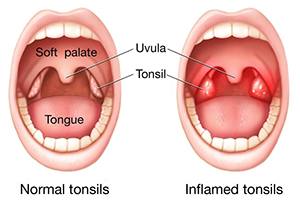-
Tonsils: Tiny, but pack a big punch

The tonsils play an essential role in keeping you healthy. These small, oval-shaped pads at the back of the throat are part of the immune system and make white blood cells. These cells attack and prevent germs that enter your body and making you sick.
While small in size, the tonsils can cause considerable pain and discomfort if inflamed. This inflammation is called tonsillitis and typically is due to a viral infection, although bacterial infections can cause tonsillitis as well.

Children are more susceptible to tonsillitis than adults for a few reasons. First, they're constantly surrounded by germs at day care or school. Kids aren't as good at hand-washing and sneezing or coughing etiquette, so there are more germs in their environments. They easily catch a cold, which can cause a runny nose and lead to tonsillitis. Their throats are smaller and many have big tonsils, which can lead to breathing problems and sleep apnea.
Sometimes, a person can have tonsillitis once or twice with no issues. But for some people, it occurs repeatedly, doesn't respond to treatments or causes complications. A common procedure called a tonsillectomy, which is the surgical removal of the tonsils, may be recommended in these cases.
Tonsillectomies are more common in children, but some adults also need them. Tonsillectomies are the second-most common procedure performed by otolaryngologists, who specialize in diagnosing and treating conditions of the ear, nose, throat, head and neck.
People who experience these symptoms may benefit from a tonsillectomy:
- Recurrent or chronic sore throat
A recurrent sore throat is having a sore throat several times a year, while a chronic sore throat lasts two or three months. These painful conditions don't seem to resolve on their own. - Frequent tonsillitis
Usually, this is defined as at least seven episodes in the previous year, at least five episodes per year for the last two years or at least three episodes per year for the past three years. - Sleep apnea caused by enlarged tonsils
When tonsils are too big, they can cause obstructive sleep apnea. The oversized tonsils block the airway, interrupting breathing and sleep. - Tonsils of different sizes
Typically, tonsils are about the same size. When one is significantly bigger than the other, both tonsils should be removed to rule out throat cancer or other serious conditions.
In the past, people needed to remain in the hospital after a tonsillectomy, sometimes for days. This has changed, and most patients can return home the same day as their surgery. The procedure takes 30–45 minutes and is performed under general anesthesia in an operating room.
Most patients experience some pain after surgery, similar to a bad sore throat. This usually lasts about a week. I recommend that most people stay home from school or work during this time, drink lots of fluids and eat soft foods.
The pain usually subsides, and most people are back to normal after about two weeks. They may continue to have some pain for longer when yawning because that motion stretches the surgical site and throat. This is normal and will decrease with time.
Overall, a tonsillectomy is a safe procedure, but there is a small risk of bleeding at the incision sites. Over time, a scab forms over the incision similar to one your body forms over a cut on your arm. There's a slight risk of bleeding when the scabs fall off about seven to 10 days after surgery.
Talk with your health care team if your or your child’s tonsils appear large or different sizes, or if either of you suffer from chronic sore throats.
Pao Vang, M.D., is an otolaryngologist in Eau Claire and Rice Lake, Wisconsin.
This article was originally posted to the Mayo Clinic Health System blog.







